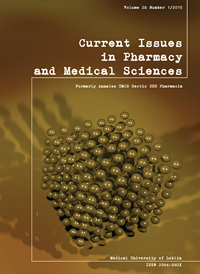Epidemiology and pathogenesis of thoracic outlet syndrome
DOI:
https://doi.org/10.1515/cipms-2015-0036Keywords:
subclavian artery, thoracic outlet syndrome, cervical ribs, brachial plexusAbstract
The superior thoracic aperture is a place particularly vulnerable to the occurrence of tissue conflict and the development of a number of neurovascular changes carrying a risk of upper limb dysfunction. The triggering factor in this case is the pressure on the nerve vascular elements brought about by too large muscles of the chest and neck, clavicle fracture and dislocation of the upper ribs, anomalies in the form of ribs, in the neck, or by apex of the lung tumors. Each anatomical anomaly may be a cause of a number of lesions and lead to the development of the disease. Due to the nature of the oppressed structures, there are two basic groups: neurogenic and vascular. The most common variant giving clinical symptoms is neurogenic thoracic outlet syndrome. In this, the compression ratio, the brachial plexus, and for this reason, the vascular surface of the upper limb dysfunction is often overlooked. However, the vascular variant, and especially arterial sub-variant, is very dangerous because it can give complications even in the form of aneurysms, and even upper limb ischemia. The aim of the study is to present the most common changes in the thoracic outlet causing functional disorders of the upper limb.
References
1. Baek J.H., Shin D.H., Kang C.K., Lee Y.B.: Distal subclavian artery occlusion causing multiple, cerebral infarcts consequence of retrograde flow of a thrombus? Cerebrovasc Endovasc Neurosurg., 15(3), 221, 2013.
2. Chang K.Z., Likes K., Davis K., Demos J., Freischlag J.A.: The significance of cervical ribs in thoracic outlet syndrome. J Vasc Surg., 57(3), 771, 2013. [CrossRef]
3. Durham J.R., Yao J.S., Pearce W.H., Nuber G.M., McCarthy W.J.: 3rd. Arterial injuries in the thoracic outlet syndrome. J Vasc Surg., 21(1), 57, 1995. [CrossRef]
4. Jusufovic M., Sandset E.C., Popperud T.H., Solberg S., Ringstad G., Kerty E.: An unusual case of the syndrome of cervical rib with subclavian artery thrombosis and cerebellar and cerebral infarctions. BMC Neurol., 28(12), 48, 2012. [Web of Science] [CrossRef]
5. Kochanowski J.: Przyczyny, symptomatologia, diagnostyka i leczenie zespołów z uwięźnięcia. Pol Przegl Neurol., 3(4), 228, 2007.
6. Malanga G.A., Landes P., Nadler S.F.: Provocative tests in cervical spine examination: historical basis and scientific analyses. Pain Physician, 6(2), 199, 2003.
7. Melliere D, Ben Yahia NE, Etienne G, Becquemin JP, Labareyre H. Thoracic outlet syndrome caused bytumor of the first rib. J Vasc Surg., 14(2), 235, 1991. [CrossRef]
8. Mouzopoulos G, Morakis E, Stamatakos M, Tzurbakis M.: Complications associated with clavicular fracture. Orthop Nurs., 28(5), 217, 2009. [CrossRef] [Web of Science]
9. Park JY, Oh KS, Yoo HY, Lee JG.: Case report: Thoracic outlet syndrome in an elite archer in full-draw position. Clin Orthop Relat Res., 471(9), 3056, 2013. [Web of Science]
10. Peet RM, et al.:Thoracic-outlet syndrome: evaluation of a therapeutic exercise program. Proc Staff Meet Mayo Clin., 31(9), 281, 1956.
11. Ronan L., D’Souza S.: Pancoast’s tumour presenting as shoulder pain in an orthopaedic clinic. BMJ Case Rep., (2), 131, 2013.
12. Sanders R.J., Hammond S.L.: Management of cervical ribs and anomalous first ribs causing neurogenic thoracic outlet syndrome. J Vasc Surg., 36, 51, 2002.
13. Sanders R.J., Annest S.J., Goldson E.: Neurogenic thoracic outlet and pectoralis minor syndromes in children. Vasc Endovascular Surg., 47(5), 335, 2013. [Web of Science]
14. Vos C.G., Dickhoff C., Paul M.A., Dahele M., Smit E.F., Hartemink K.J.: Treatment and prognosis of superior sulcus tumours. Ned Tijdschr Geneeskd. 156(49): 5419; 2012.
15. Walden M.J., Adin M.E., Visagan R., et al.: Cervical ribs: identification on MRI and clinical relevance. Clin Imaging., 37(5), 938, 2013. [Web of Science] [CrossRef]
16. Weber A.E., Criado E.: Relevance of bone anomalies in patients with thoracic outlet syndrome. Ann Vasc Surg., 28(4), 924, 2014. [CrossRef]
17. Yun D.H., Kim H.S., Chon J., Lee J., Jung P.K.: Thoracic outlet syndrome caused by schwannoma of brachial plexus. Ann Rehabil Med., 37(6), 896, 2013. [CrossRef]
Downloads
Published
Issue
Section
License
Copyright (c) 2015 Authors

This work is licensed under a Creative Commons Attribution-NonCommercial-NoDerivatives 3.0 Unported License.


